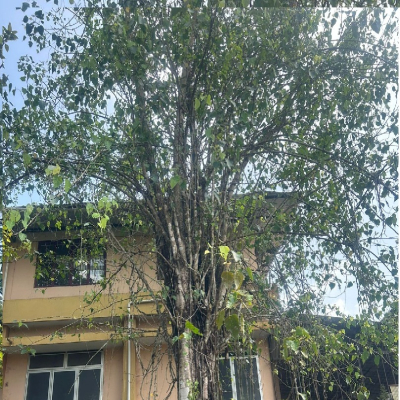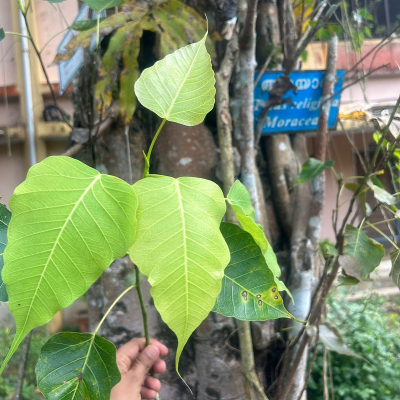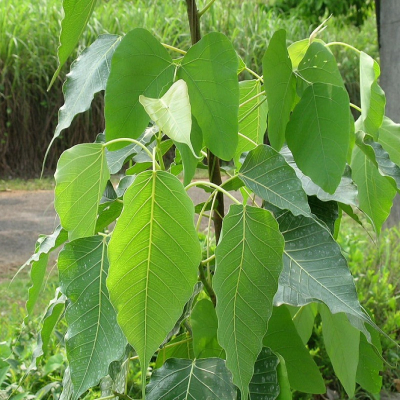Ficus religiosa Linn.
Family : Moraceae
Group : 5. Nalpamaram, 6. Star trees
Parts Used : Fruit , Leaf , Bark , Latex , Young shoots
Vernacular Names :-
| English | : | Peepal tree, Sacred fig |
| Malayalam | : | Arayal |
| Hindi | : | Pippal |
| Sanskrit | : | Pippalah, Asvatthah |
| Bengali | : | Asvatha |
| Gujarathi | : | Jari |
| Kannada | : | Aswatha |
| Tamil | : | Arasu |
| Telungu | : | Ravi |
Distribution and Habitat: Peepel tree or sacred fig is a large deciduous tree with few or no aerial roots. It is common throughout India, often planted in the vicinity of the temples.
Botany: A large tree frequently epiphytal.
- Leaves: Leathery, broadly ovate, entire, undulate, tip narrowed into a linear, tail like point, petiolate, petiole 7.5-10 cm long.
- Flowers: Flowers during February. Male flowers few, sessile. Gall and fertile flowers are sessile or pedicellate, the gall flowers much more numerous than the fertile females and many of without perianth.
- Fruits: Unique fruit called syconium, a fleshy hollow structure lined on the inside with hundreds of tiny seeds; 4-7 mm in diameter and 0.4-0.5 g weight, pink, purple or black on ripening; Fruits are borne on young branches. Figs axillary, sessile, in pairs, globose, slightly vertically flattened, 12 mm in diameter, dark purple when ripe.
- Seeds: Tiny sized, 100-120 nos. per fruit. Seeds mature in May – June.
Properties:
- Bark is hypoglycaemic. Stem bark is antiprotozoal, anthelmintic and antiviral. Bark is astringent, antigonorrheic, febrifuge, aphrodisiac and antidysenteric.
- Syconium, leaf and young shoot are purgative.
- Fruits are laxative and digestive.
- Seeds are refrigerant and laxative.
Chemical constituents:
- Bark gives b-sitosterol and its D-glucoside,.
- Stem bark contain vitamin K, stigmasterol, Phytosterolin and 4% of tannin.
- Leaves have protein and amino acids.
Uses: It is used in the treatment of gonorrhoea, diarrhoea, dysentery, haemorrhoids and gastrohelcosis.
- A paste of the powdered bark is a good absorbent for inflammatory swellings. It is also good for burns.
- Leaves and tender shoots have purgative properties and are also recommended for wounds and skin diseases.
- The dried fruit pulverized and taken in water cures asthma.
- The latex is good for neuralgia, inflammations and haemorrhages
Formulations: Nalpamaradi tailor, Saribadyasava, Candanasava, Karnasulantaka, Valiyamarma gulika etc
Agro technology
Soil and Climate: Deep, alluvial sandy loam with good drainage. The annual rainfall requirement for this species is 500 mm to 5000 mm during the monsoon season. The maximum temperature is 46ºC, while the minimum seldom goes below freezing point.
Propagation: Seeds, stump or branch cuttings, wildlings and air layering
Seed treatment : Soak seeds in hot water at 65 ̊C for 10 minutes and sow in fine medium like leaf compost, composted coirpith etc.
Sowing: Ripe fruits are collected, rubbed and washed to get clean seed which is dried under sun before fresh sowing or storage. Seeds have viability up to 12 months. Seed is dibbed in poly bags or broadcasted on seed beds either in March-April or June-July and lightly covered with thin soil. It takes 15-24 days for germination. 7-8 months old seedlings are transplanted to field.
Cuttings having thickness of 15 - 25 mm are used for planting. It takes 2-3 weeks to sprout. 2-2.5 months old rooted cuttings are transplanted to the field.
Air layering is also practiced in the month of May to June; layering in branches of old trees register 80-90 % rooting.
Spacing : 6 m x 6 m
Seed requirement per acre : 0.2 g
No. of plants per acre : 110 nos.




